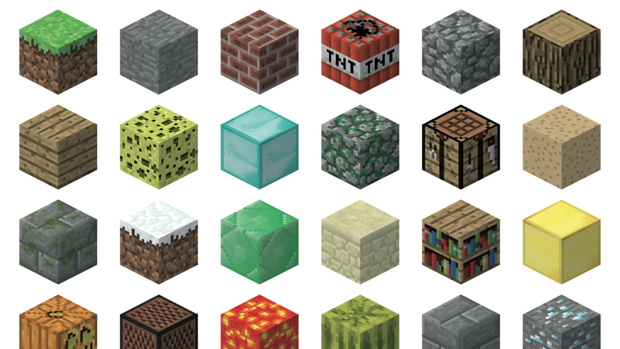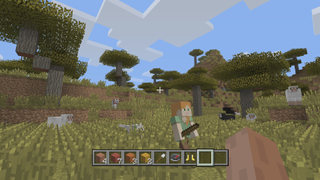Air pockets, soul sand and dragon eggs - why I love Minecraft blocks

I’ve played a lot of Minecraft over the years. I first played it way back in 2009 when it was a browser game and you couldn’t do much beyond placing and destroying blocks. I’ve played with my kids, with friends, on my own, and also to research a book I wrote called the Minecraft Blockopedia.
The thing that’s sustained my interest for so long is Minecraft’s depth. With knowledge of the properties of all its blocks, you can build amazing things, like functional word processors and scale representations of Battlestar Galactica, as well as simply survive and make the land around you habitable. In writing the book I came across some fascinating characteristics that helped me appreciate Minecraft even more. Here are some of the things that particularly intrigued me.

First, and it’s something that kinda digs a nail under and starts to expose the true nature of Minecraft, is the fact that air is a block. It has the block ID of 0, despite being nothing. You can’t pick it up, not even with the Silk Touch enchantment. But Minecraft is a world made in a computer, and computers don’t do nothing very well, so they have to count the absence of things as a thing, if you get what I mean. So air has a value.
Effectively, you create air by destroying blocks and destroy air by placing blocks. But while air would appear to have no specific purpose, it does actually play a role in the game, due to the fact both you and mobs (any living creature) can suffocate. Essentially, for the time the top half of a body is inside any solid block, it receives damage. Being engulfed in falling sand or gravel is a common cause, but you can also be suffocated by riding a minecart or pig into a single block gap. In the history of dumb deaths, these are up there.

Oddly, you can’t be suffocated by transparent blocks. This is because Minecraft doesn’t look at blocks in terms of solidity, and instead uses transparency as an indicator of block type. This property extends across all sorts of strange rules. For instance, mobs can’t spawn on transparent blocks. But you can’t place signs or torches on transparent blocks either.
Something that’s very handy about non-solid transparent blocks, such as signs, torches and iron bars, is the fact that they create air pockets in water. This property is a good way of avoiding drowning – just put a sign down on a sea bed and another on top of that and you’ve got a two-block area you can go to catch your breath. Remember this: it could be a lifesaver.

Soul sand is another of my favourites. I don’t only like it because it looks like it’s made from screaming faces. I like it because it’s functionally weird, too. Anything walking on it is severely slowed, including you, because you sink into it a little. But weirder is the fact that if you put a layer of ice underneath a bed of soul sand, anything on it moves even slower.
Sign up to the 12DOVE Newsletter
Weekly digests, tales from the communities you love, and more
You used to be able to use the sinking property to make one-way doors, by placing soul sand in front of a two-block high doorway. The small hop up from the slight dip sees you collide with the door frame and you’re blocked from moving through it. Mojang patched this out – fair enough; it was probably a bug and it made no sense – but I think not making sense is the whole point of soul sand. Ah, well.

Command blocks are the subject of a lot of confusion, frustration and hope. They’re incredibly powerful, giving you the ability to change the rules of the world, give players items, modify mob behaviour and more. As such, they’re great for building worlds with stories or complex game designs – but they’re not in the Xbox versions of the game. Not quite, anyway. You can see one, if you hack a world by saving it to a USB drive, import it into Windows using Horizon, and use the oPryzeLP MC360 mod tool to add the command block to your inventory before exporting the save back to the USB drive. But while the command block will be placeable, it sadly doesn’t work.
In defence of this decision, command blocks aren’t exactly intrinsic to the PC version. They’re only available from the command line and they’re super hard to use. They’re essentially a programming interface and involve typing lines of code. Still, it would be fantastic to be able to play command block-powered worlds on Xbox One or Xbox 360. Here’s hoping.

Minecraft’s history is one of players feeling out how to do everything, from making a pickaxe in the early days to summoning the Wither. When it was first released there was no tutorial; nothing to tell you how to survive or even why you should want to. Everything that’s known about Minecraft today is the result of what players have discovered for themselves and shared with others.
One of the most interesting challenges is to collect a dragon egg. To get one you need to kill the Ender Dragon, and that means reaching The End, which is a huge challenge in itself. Once the dragon’s dead, a portal opens back to the Overworld, and on top of that appears – for the first time you kill the dragon in a world only – a dragon’s egg. But you can’t pick it up. If you do, it teleports somewhere else in the area. And if you make it fall, it’ll smash, unless you make it fall on to one of those non-solid blocks I mentioned earlier, like a sign or torch. The skill, dedication, knowledge and equipment to get to and kill the dragon, and then to grab its egg... The fact it’s useless just adds to the fact that for me, the dragon egg epitomises what it takes to be a truly great Minecraft player.
This article originally appeared in Xbox: The Official Magazine. For more great Xbox coverage, you can subscribe here.

















